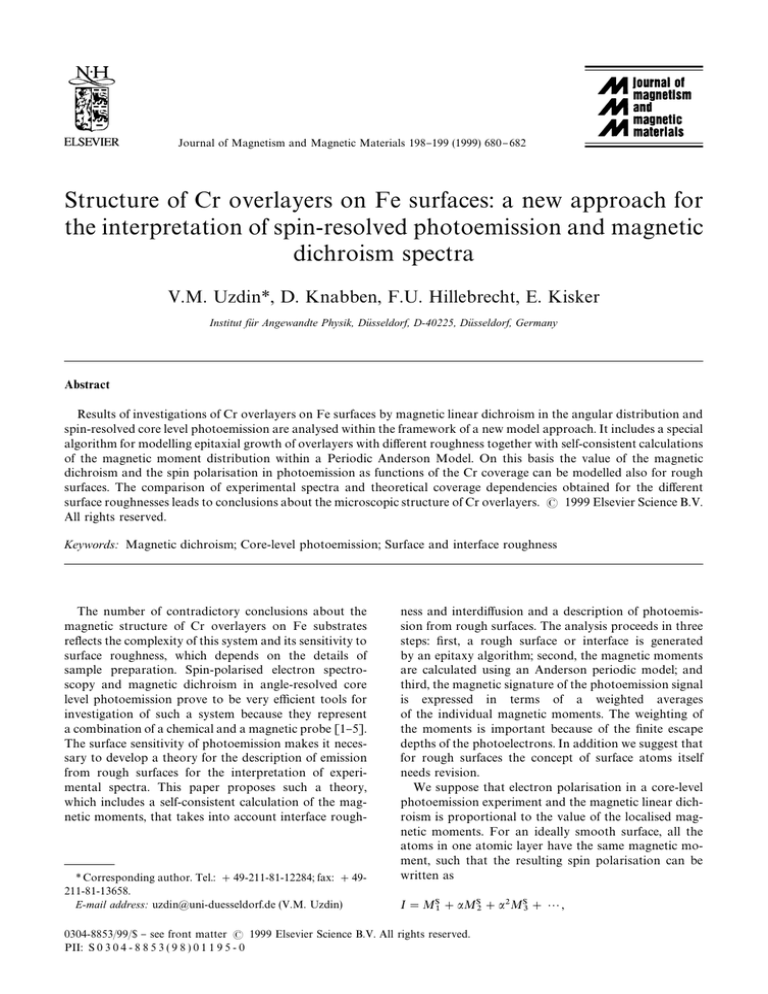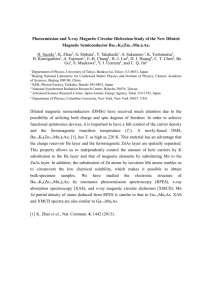
Journal of Magnetism and Magnetic Materials 198}199 (1999) 680 }682
Structure of Cr overlayers on Fe surfaces: a new approach for
the interpretation of spin-resolved photoemission and magnetic
dichroism spectra
V.M. Uzdin*, D. Knabben, F.U. Hillebrecht, E. Kisker
Institut fu( r Angewandte Physik, Du( sseldorf, D-40225, Du( sseldorf, Germany
Abstract
Results of investigations of Cr overlayers on Fe surfaces by magnetic linear dichroism in the angular distribution and
spin-resolved core level photoemission are analysed within the framework of a new model approach. It includes a special
algorithm for modelling epitaxial growth of overlayers with di!erent roughness together with self-consistent calculations
of the magnetic moment distribution within a Periodic Anderson Model. On this basis the value of the magnetic
dichroism and the spin polarisation in photoemission as functions of the Cr coverage can be modelled also for rough
surfaces. The comparison of experimental spectra and theoretical coverage dependencies obtained for the di!erent
surface roughnesses leads to conclusions about the microscopic structure of Cr overlayers. 1999 Elsevier Science B.V.
All rights reserved.
Keywords: Magnetic dichroism; Core-level photoemission; Surface and interface roughness
The number of contradictory conclusions about the
magnetic structure of Cr overlayers on Fe substrates
re#ects the complexity of this system and its sensitivity to
surface roughness, which depends on the details of
sample preparation. Spin-polarised electron spectroscopy and magnetic dichroism in angle-resolved core
level photoemission prove to be very e$cient tools for
investigation of such a system because they represent
a combination of a chemical and a magnetic probe [1}5].
The surface sensitivity of photoemission makes it necessary to develop a theory for the description of emission
from rough surfaces for the interpretation of experimental spectra. This paper proposes such a theory,
which includes a self-consistent calculation of the magnetic moments, that takes into account interface rough-
* Corresponding author. Tel.: #49-211-81-12284; fax: #49211-81-13658.
E-mail address: uzdin@uni-duesseldorf.de (V.M. Uzdin)
ness and interdi!usion and a description of photoemission from rough surfaces. The analysis proceeds in three
steps: "rst, a rough surface or interface is generated
by an epitaxy algorithm; second, the magnetic moments
are calculated using an Anderson periodic model; and
third, the magnetic signature of the photoemission signal
is expressed in terms of a weighted averages
of the individual magnetic moments. The weighting of
the moments is important because of the "nite escape
depths of the photoelectrons. In addition we suggest that
for rough surfaces the concept of surface atoms itself
needs revision.
We suppose that electron polarisation in a core-level
photoemission experiment and the magnetic linear dichroism is proportional to the value of the localised magnetic moments. For an ideally smooth surface, all the
atoms in one atomic layer have the same magnetic moment, such that the resulting spin polarisation can be
written as
I"M1 #aM1 #aM1 #2,
0304-8853/99/$ } see front matter 1999 Elsevier Science B.V. All rights reserved.
PII: S 0 3 0 4 - 8 8 5 3 ( 9 8 ) 0 1 1 9 5 - 0
V.M. Uzdin et al. / Journal of Magnetism and Magnetic Materials 198}199 (1999) 680 } 682
681
where M1 is the local magnetic moment of S type atoms
G
(S"Fe or Cr) from ith layer, and a takes into account
the attenuation of the photoelectron signal arising from
non-surface layers due to the "nite mean free path. In
a simple approach, a can be expressed through a universal escape depth j, which depends on the kinetic energy
of the photoelectrons, and a characteristic length ¸,
which is proportional to the lattice constant and determined by geometry of experiment:
a"exp(!¸/j).
For rough interfaces, where a given atomic layer may
contain Fe and Cr atoms with di!erent magnetic moments as well as empty sites, we obtain for the normalised
di!erence between the number of electrons with spin up
and spin down projection emitted from the surface
(I"(I !I )/(I #I )) the following expression:
>
\ >
\
N
M1 \ 1#(a!1) H
G G N
I"
,
N
H
N1 \ 1#(a!1)
G G N
Fig. 1. Coverage dependence of polarisation on Cr atoms for
a Cr overlayer on Fe with &smooth' interface generated by
algorithm &epitaxy' (interface region is 2}3 layers). Di!erent
symbols correspond to various values of the parameter a.
where M1 and N1 are the total magnetic moment and
G
G
d-electron number on S type atoms in the i-layer; N /N is
H
the fraction of the "lled sites in layer j.
To model rough surfaces and interfaces, we use an
&epitaxy' algorithm [6], which "lls the sites of the ideal
bcc lattice inside a prism of 8;8;20 atoms (Fe or Cr)
using a special random procedure. Outside the prism we
chose periodic boundary conditions. Variation of the
parameters in the algorithm allows one to create samples
with di!erent interface roughness. For determination of
the average, the sample construction was repeated 20
times, and for each of these con"gurations the d-electron
number and the magnetic moment on every site were
calculated within Periodic Anderson Model [6]. A distribution of the magnetic moments is determined self-consistently in the mean-"eld approximation by taking into
account the d}d interaction in the "rst coordinate sphere
of the atoms. Parameters of the model were chosen so as
to reproduce the bulk Fe and Cr moments and the
d-electron numbers.
The coverage dependencies of the polarisation on Cr
atoms as calculated for a smooth interface (2}3 layers
containing both Fe and Cr atoms) and for a rough
interface (Fe and Cr intermixed in 10}11 layers) are
depicted in Figs. 1 and 2. In both cases, the Cr polarisation is negative for low Cr coverage [1}5]. This is related
to the antiferromagnetic coupling between the Cr submonolayer and the Fe substrate. The polarisation may
oscillate [3,4] or decrease monotonically with coverage
[2,5], depending on the surface roughness and interdi!usion in the interface region. In the case of an oscillatory
behavior, the oscillations are more pronounced for small
a. The maximal positive polarisation, when the sign of
Fig. 2. Coverage dependence of polarisation on Cr atoms for Cr
overlayer on Fe with &smooth' interface generated by &epitaxy'
(interface region is 10}11 layers). Di!erent symbols correspond
to various values of the parameter a.
the polarisation coincides with that of the Fe atoms,
occurs at Cr coverage 2 ML. For ideally smooth surfaces
such behaviour is quite natural. The "rst Cr monolayer
on Fe has a surface-enhanced moment opposite to the Fe
moments. When another &ideally smooth' Cr layer is
deposited, it will have a surface-enhanced moment opposite to that of the previous layer. Furthermore, it will
reduce the value of the magnetic moment of the previous
layer, because the atoms in that layer cease to be at the
surface. That is why with every monolayer one can expect
a change of the sign of polarisation. Roughness will erode
such an oscillation, but as is seen in Fig. 1, it does not
destroy the oscillation for relatively smooth surfaces. For
rough interfaces, this signature of the antiferromagnetic
structure is fully destroyed, as is seen in Fig. 2.
Comparison of the experimental [4] and theoretical
curves suggests some conclusions about the microscopic
structure of the Cr overlayer. Theory predicts a monotonic change of the spin polarisation up to 2 ML Cr
coverage, and even a change of sign of polarisation
near this point for smooth surfaces. The dichroism
682
V.M. Uzdin et al. / Journal of Magnetism and Magnetic Materials 198}199 (1999) 680 } 682
experiment, in contrast, shows an oscillation and a maximum instead of a minimum for 2 ML coverage [4]. This
contradiction can be explained if one supposes a nonuniform growth of the second layer. If the growth of the
overlayer passes through that stage when the formation
of the second Cr ML is suppressed, then instead of
uniform coverage we obtain a superposition of 1 and
3 ML coverages and an increase of the absolute value of
dichroism on Cr atoms results. Further deposition of Cr
leads to the "lling of the space around islands, which
decreases the absolute value of dichroism. The physical
reason for the three-dimensional growth can be connected with electron con"nement in the Cr islands on Fe and
with an oscillation of the energy of these electrons with
thickness of islands [7], in a similar manner to the quantum well model for exchange coupling oscillation [8].
The same mechanism may be responsible for the nonPoisson island growth reported in Refs. [2,5].
Acknowledgements
This work is partially supported by INTAS Project
No. 96-0531. VMU would like to express his gratitude to
the Alexander von Humboldt foundation for support.
References
[1] F.U. Hillebrecht, Ch. Roth, R. Jungblut, E. Kisker, A.
Bringer, Europhys. Lett. 19 (1992) 711.
[2] Y.U. Idzerda, L.H. Tjeng, H.-J. Lin, J. Gutierrez, G. Meigs,
C.T. Chen, Phys. Rev. B 48 (1993) 4144.
[3] T.G. Walker, A.W. Pang, H. Hopster, S.F. Alvarado, Phys.
Rev. Lett. 69 (1992) 1121.
[4] D. Knabben, Th. Koop, H.A. DuK rr, F.U. Hillebrecht, G. van
der Laan, J. Electron Spectrosc. Relat. Phenom. 86 (1997)
201.
[5] T. BoK ske, W. Clemens, D. Schmitz, J. Kojnok, M. SchaK fer,
V. Cros, G.Y. Guo, W. Eberhardt, Appl. Phys. A 61 (1995)
119.
[6] A.K. Kasansky, V.M. Uzdin, Phys. Rev. B 52 (1995) 9477.
[7] V.M. Uzdin, D. Knabben, F.U. Hillebrecht, E. Kisker, Phys.
Rev. B 59 (1999) 1214.
[8] V.M. Uzdin, N.S. Yartseva, J. Magn. Magn. Mater. 156
(1996) 193.



